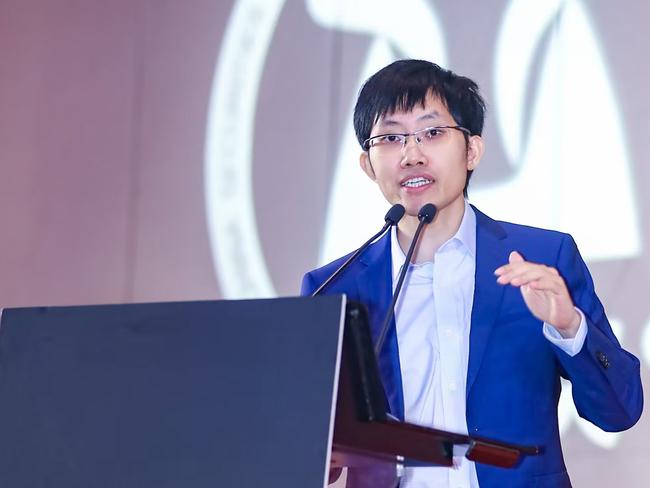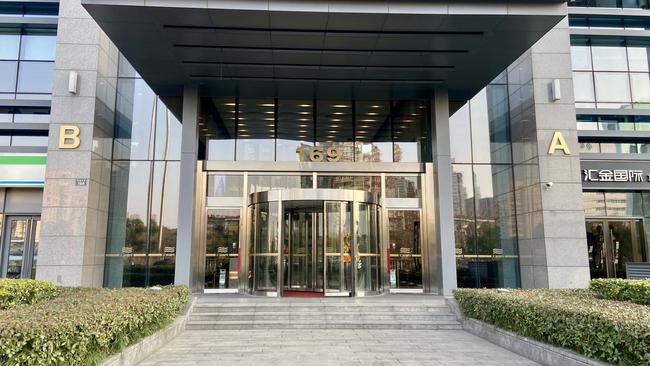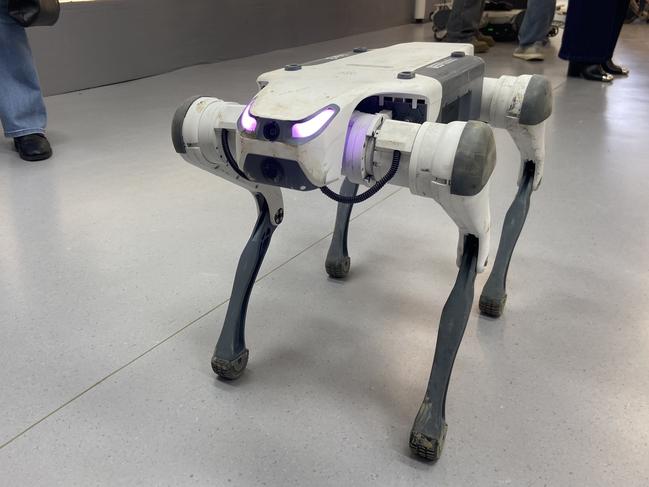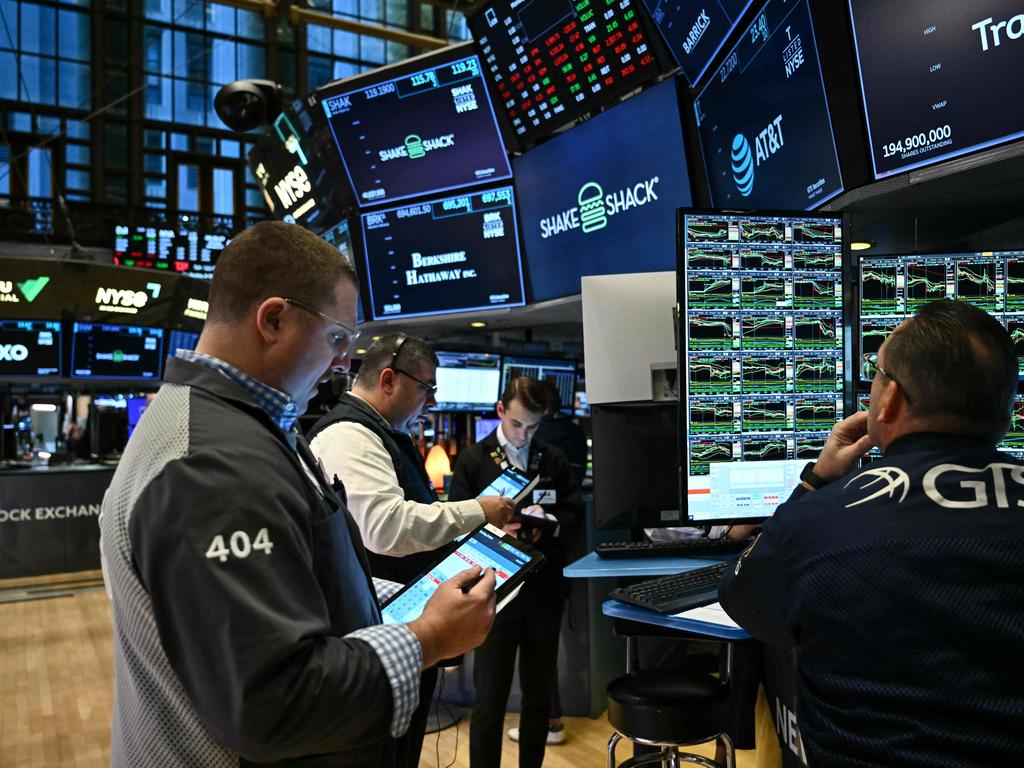Journey into China’s AI super hub
Liang Wenfeng, 40, has suddenly become a pin-up for Beijing, a darling of China’s private sector and an idol to many young Chinese inspired by his desire to be ‘an innovator, not just a follower’.
From around China, the pilgrims come to the headquarters of DeepSeek, the Chinese artificial intelligence company that has shaken the world. Mr Shen, 39, travelled to DeepSeek’s glistening marble office foyer in Hangzhou from Sichuan, 1800km away in China’s west.
He works in the real estate industry, which remains in its biggest slump since China allowed private home sales in the 1990s. He came with no experience in AI and no relevant qualification but hoped he could snare a job in an industry with an “upward trend”.
“I don’t care about the position. I’ll be fine as long as I can drive a car for them,” he tells the Guangzhou Daily.
It is an unlikely spot for reverence. When The Australian visited this week, an instrumental version of George Michael’s Careless Whisper echoed through the marble foyer. There was no signage noting the famous tenant upstairs. It could hardly have looked more bland.
The only indication that this was a place of global interest was the journalist from The Financial Times I spotted attempting, as I had earlier, to sneak up the lift to the secretive offices above.
Upstairs, a team of mostly 20-something AI developers were working furiously on the follow-up to their R1 model, which they launched in January.
That version triggered a $1.5 trillion sell-off in global equities, pummelled the Nasdaq-listed chip giant Nvidia and indicated that the US lead over China in AI was far smaller than many had believed. Its date of release, on the day Donald Trump was inaugurated as US President again, could not have been more pointed.
Science and technology are long-time obsessions of the Chinese Communist Party. A foundational idea in the party’s history is that China’s technological backwardness in the 19th century left the Chinese empire vulnerable to foreign powers.
Beijing is determined never to be in that position again.
“The nation will thrive when science and technology develops, and the country will be strong when science and technology becomes advanced,” President Xi Jinping said in an address to scientists and officials last year.
DeepSeek’s introverted billionaire founder, Liang Wenfeng, 40, has suddenly become a pin-up for Beijing, a darling of China’s private sector and an idol to many young Chinese inspired by his desire to be “an innovator, not just a follower”.

It is a remarkable transformation for a geeky entrepreneur who made his fortune as the founder of quantitative hedge fund High-Flyer, a business loathed by Chinese officials who have complained that the sector exploits less savvy retail shareholders.
In a rare interview last July, Liang said China was approaching a tipping point for innovation. He said the only barrier now was self-confidence.
“I believe innovation is, first and foremost, a matter of belief. Why is Silicon Valley so innovative? Because they dare to try.
“When this society starts celebrating the success of deep-tech innovators, collective perceptions will change. We just need more real-world examples and time to allow that process to unfold,” he said.
Six months later, DeepSeek has become such a real-world example. Chinese media is saturated with stories about its adoption by consumers, local governments and businesses.
Tech giant Tencent last week embedded it in its ubiquitous social media app WeChat. Tencent’s servers crashed as tens, if not hundreds, of millions of people in China added to the more than 100 million people who had downloaded it in its first few weeks since release.

DeepSeek’s triumph has helped Chinese tech stocks on Hong Kong’s Hang Seng TECH Index surge almost 40 per cent this year, as investors return to a sector that has languished for years.
Next week, Xi, Premier Li Qiang and thousands of their comrades will gather in Beijing for China’s flagship annual political meeting, the National People’s Congress.
In 2024 the congress was held amid the thick gloom of China’s property sector, whose historic troubles remain.
DeepSeek’s success, along with the Chinese animated movie blockbuster Ne Zha 2 (the highest grossing movie screened in China) make for a welcome additional backdrop to the 2025 meeting, which is used to co-ordinate policymaking for the year ahead.
Both Xi and Li have held meetings with the DeepSeek founder and other leading figures in China’s private sector in the weeks leading up to the gathering. The message has been that the private sector is wanted, albeit on Beijing’s terms.
“Entrepreneurs should be full of entrepreneurial and patriotic passion, continuously elevate their ideals and cultivate a deep sense of national responsibility,” Xi said.
The Chinese leader’s much-publicised meeting also included Alibaba founder Jack Ma – a rare sighting of a businessman who has kept an extremely low profile since he was made the biggest target in Beijing’s crackdown on the tech sector in late 2020.

After this noteworthy Chinese spring, businesspeople, and the tech sector in particular, are feeling more supported than they have in years. They know the reasons for Beijing’s advances.
“China’s economy has a lot of problems,” a Beijing-based analyst of China’s tech sector tells The Australian. “The leadership needs the private sector to revive China’s economy. They need the hi-tech industry to stand in and support it.”
The latest Chinese ‘Silicon Valley’
Hangzhou sits on China’s east coast, about 170km southwest of Shanghai. Right now it is humming with entrepreneurs trying to get in on China’s hi-tech business wave.
The city, the capital of Zhejiang province, has been famous since the Tang dynasty for its beautiful West Lake.
More recently, it has been making headlines as “China’s Silicon Valley”, although previous tech waves have seen that title also given to the southern Chinese city of Shenzhen – home of internet giant Tencent, EV maker BYD and the world’s dominant drone maker, DJI – along with Beijing’s Haidian District, near Peking and Tsinghua universities, home of computer maker Lenovo, search giant Baidu and TikTok’s parent company, ByteDance. China, it seems, is too big, and its provincial and city governments too competitive, to have just one hi-tech cluster.
Behind Hangzhou’s success are local and provincial governments that are particularly responsive to the needs of private businesses. They are generous too: Zhejiang just passed the biggest science and technology budget of any province in China, soaring 15 per cent to 101.9 billion yuan (about $22.4bn).
The anchor role of Ma’s tech giant Alibaba, the city’s biggest company and an investor in many of its local businesses, also has been critical. So has Hangzhou’s illustrious Zhejiang University, which has a focus on nurturing enterprises that is unusual in China.
“We have been having this hot soil for companies for a long time,” one Hangzhou investor tells The Australian.
An afternoon at a networking event run by a government-linked business chamber showed the scene in action. One by one, entrepreneurs – many running AI start-ups but also green energy businesses and medical tech companies – introduce themselves.
Afterwards a flurry of mostly state-owned banking employees and venture capitalists pounce on attractive-sounding prospects. Officials from other cities in Zhejiang offer incentives for the budding entrepreneurs to set up in their various industrial parks and tech clusters (which seem to be in every city in China).
“DeepSeek is just the start. It’s not the end,” a Hangzhou business figure with close links to the government tells The Australian.
The AI company’s breakthrough has cast a spotlight on Hangzhou’s other “six little dragons”, a group of promising tech start-ups.
Three were founded by graduates from Zhejiang University: DeepSeek, Manycore Tech, a 3D-design software firm, and Deep Robotics, which makes dog-inspired robots used for patrolling, rescue operations and, as demonstrated in the showroom at the company’s headquarters, delivering takeaway coffees.

Students at Zhe Da, as the university is commonly known, say it is modelling itself on Stanford University, the Californian institution with deep links to the actual Silicon Valley. It certainly has a track record of producing successful entrepreneurs. In addition to DeepSeek’s Liang (who studied AI at the university), Colin Huang, the founder of Chinese e-commerce giant Pinduoduo, and electronics billionaire Duan Yongping are also alumni.
Its professors are unusual, too. Zhu Qiuguo, the founder of the “little dragon” Deep Robotics, is also a professor at Zhe Da’s school of engineering.
Xi is also familiar with its sprawling campus, thanks to his stint two decades ago as Zhejiang’s party secretary, the most senior political position in the province. Many of his visits are memorialised on the “Xi wall” at the university’s museum.
The university was founded in 1897. Its founding mission was to introduce European, American and Japanese educational ideas into China to help the country develop. Its inaugural “chief teacher” was an American, EL Mattox, who taught physics and chemistry.

Today, China is America’s “most formidable technological and scientific competitor”, as Michael Kratsios, the Trump administration’s nominee to head the White House Office of Science and Technology Policy, said this week. “The shape of the future global order will be defined by whomever leads across AI, quantum, nuclear, and other critical and emerging technologies,” he said.
Nearing a breaking point?
China’s AI industry was one of the priority areas in the notorious industrial policy initiative called Made in China 2025, which Xi unveiled a decade ago.
In his first presidential term, Trump claimed he had convinced Beijing to tear up that blueprint to dominate the industries of the future. “China got rid of their ‘China ’25’ because I found it very insulting,” Trump said in 2018. “I said, ‘That’s not happening.’ ”
Beijing did stop using the banner phrase after the monumentally ambitious industrial policy set off alarm bells in Washington and across European capitals. But, if anything, the Chinese government has only increased its industrial support as it has encountered pushback.
To take just one example, the Chinese central government’s science and technology annual budget last year was 1.150 trillion yuan (just over $250bn). That’s more than 100 times the sum the Albanese government has committed to its Future Made in Australia program (a total of $22.7bn across 10 years).
While undoubtedly resulting in a huge amount of wasteful government spending, by many measures China has been stunningly successful.
A team of Bloomberg researchers, including former CIA China-economics analyst Gerard DiPippo, judged Beijing had achieved a global leadership position in five of the 13 technologies outlined in its 2015 plan: drones, solar panels, high-speed rail, electric vehicles and lithium batteries.
In almost all the rest, including robotics, AI, machine tools and semiconductors, China had transformed across the decade from a laggard to a serious competitor.
“Despite more than six years of US tariffs, export controls and financial sanctions, Xi is making steady progress in positioning China to dominate industries of the future,” Bloomberg assessed.
Business figures in Hangzhou say they are not worried about future American efforts at economic containment.
“More pressure will only increase innovation in China’s technology and scientific industry. If you don’t sell to us, we’ll make it by ourselves,” one business figure with close links to government officials tells The Australian.
Some analysts argue that China can pull ahead of the US in further industries, even if it is still lagging in scientific research.
Dan Wang, an expert on China’s technological capabilities at Yale University’s Paul Tsai China Centre, has argued that too many analysts overlook China’s genius at manufacturing.
“At the heart of the country’s ascendancy in advanced technology … is its spectacular capacity for making things,” he has argued in Foreign Affairs.
The solar industry has been a telling case study. “Advances in solar over the last decade have been driven less by breakthroughs in science – America’s specialty – than by driving costs down through more efficient production, which is China’s strength,” Wang says.
Others see a disaster looming after the greatest industrial policy program in the 21st century.
“Despite creating some of the world’s most impressive companies, China’s supply side policy bias has generated incredible levels of local government debt, destructive price wars, and significant amounts of wasted resources,” Joerg Wuttke, who until 2023 was the long-serving president of the EU Chamber of Commerce in China, argued this week.
“China’s overcapacity problem is nearing its breaking point, and it does not appear Beijing has the ability to address it.”
For now, though, China’s leaders are enjoying their best spring in years.








To join the conversation, please log in. Don't have an account? Register
Join the conversation, you are commenting as Logout